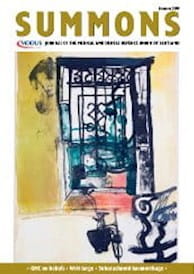ANEURYSMAL subarachnoid haemorrhage (SAH) is a rare condition with an incidence of approximately 8 per 100,000 per annum in the UK. A GP is unlikely to see more than a few cases over the course of a career but the potential for missed or delayed diagnosis makes it a significant litigation risk.
The mean age for SAH is 51 years. Approximately 50 per cent of patients die of the condition – 30 per cent immediately and 20 per cent from complications in subsequent days or weeks. However, for those with less devastating bleeds there is excellent potential for a good outcome.
SAH classically presents with sudden onset of severe headache. Suddenness of onset is usually the key feature. The headache itself is not always described in dramatic terms, such as ‘thunderclap’, and the patient may look deceptively well. Early vomiting is common and often followed by neck stiffness and photophobia. More severe cases may have a temporary or prolonged decrease in conscious level, with or without focal signs such as hemiparesis, dysphasia or third nerve palsy. Cardiac abnormalities and ECG changes may result and should not distract the clinician from the complaint of severe headache.
A CT scan performed within 24 hours is well over 90 per cent sensitive for SAH, dropping to about 60 per cent after five days. In the majority of cases with a typical presentation, scanning confirms the diagnosis quickly and easily. Patients with SAH can be graded according to clinical condition: Grade I being fully conscious with no focal signs and Grade V being deeply comatose. Grade I and II patients treated expeditiously have a good or moderately good outcome in 80 per cent of cases. Treatment may be by endovascular coiling by an interventional neuroradiologist, or by craniotomy and clipping by a neurosurgeon.
Medico-legal risk
Unfortunately, the diagnosis may be missed or delayed, especially in fully conscious patients who look relatively well on presentation. This not uncommonly leads to litigation. Re-bleeding is the most serious potential complication of a missed diagnosis. Untreated, a ruptured aneurysm has a 6-8 per cent chance of re-bleeding within the first 3 days and a 20 per cent risk within 2 weeks. Re-bleeding carries 70-80 per cent mortality.
In a recent analysis of 26 cases of SAH referred for independent medico-legal review, errors of diagnosis were seen in 13 cases, and delays in diagnosis in six. The most common misdiagnosis was migraine. Thirteen of the patients had a fatal outcome and six were severely disabled. In 50 per cent of cases it was judged that a more favourable outcome would have occurred but for the breach of duty of care, and all these actions were successful. In all cases, clinical features were present which would have enabled the clinician to reach the correct diagnosis (Brit.J.Neurosurg, 2009; 23(2):116).
Making the right diagnosis
The initial suspicion of SAH is based on the history either from the patient or from witnesses if the patient is confused or worse. A history consistent with SAH demands emergency admission to hospital even if the suspected bleed was days earlier and the patient appears well.
Example: a patient in her sixties presented to a stroke clinic with a history of sudden onset headache 10 days previously. A CT scan carried out the same day was normal. She was referred by letter to a neurosurgical unit.
If this patient had indeed suffered a SAH and had re-bled during the 2 weeks it took for the letter to arrive at the neurosurgical unit, it would have been difficult to defend the referring clinician’s action.
In cases of suspected SAH, a CT scan should be carried out as soon as possible. If this is negative, a lumbar puncture (LP) must be performed. It is crucial that the LP be performed by an experienced doctor and that arrangements are in place to transport the cerebrospinal fluid (CSF) to biochemistry immediately.
There seems to be a notion that it does not matter much if the LP gives an equivocal or false positive result because the patient can be referred for a CT angiogram anyway. This attitude is bad medicine and betrays a false assumption that if an aneurysm is seen on angiography the patient must have had an SAH.
Approximately 2 per cent of the population have unruptured asymptomatic aneurysms. Most incidental unruptured aneurysms do not justify treatment as the risks of treatment may equal or exceed the long-term risk of rupture. Therefore, it can disadvantage a patient to discover an unruptured aneurysm. Apart from the anxiety caused there can be implications for many other areas of life.
Example: a female in her late twenties presented with a history consistent with SAH and a normal CT scan. The LP was done inexpertly, with multiple attempts causing bleeding into the CSF. The CSF itself was not examined quickly enough or properly. By the time the patient came to neurosurgery, it was impossible to determine whether she had bled or not. Angiography was performed which showed small right and left-sided middle cerebral artery aneurysms which were deemed unsuitable for coiling. She underwent bilateral craniotomies for clipping of the aneurysms. At operation, it was clear that neither aneurysm had bled.
Because of a poorly performed LP this patient underwent the risk of two craniotomies. Post-operatively, she complained of poor memory, wound discomfort, scalp dysaesthesia and some cosmetic deficit. She lost her driving licence for 6 months and has a lifetime risk of epilepsy. The aneurysms themselves carried a negligible lifetime risk of rupture, and the patient would have been far better off with a proper LP and no further action.
Diagnosis by lumbar puncture depends upon finding haemoglobin breakdown products in the CSF. The LP should be performed at least 12 hours after the suspected haemorrhage to allow adequate time for red blood cells to lyse releasing oxyhaemoglobin. Three bottles of CSF should be collected. The LP can cause some bleeding into the CSF but if this occurs, the red blood cell count should decrease on the second and third bottles collected.
The first bottle should be sent to bacteriology, the second bottle for cell count and the third bottle sent without delay to biochemistry and centrifuged promptly, ideally within 15 minutes. If the LP has caused bleeding into the CSF, any delay in centrifuging the specimen can lead to false positive results due to release of oxyhaemoglobin. Centrifuging within 15 minutes and examination by spectrophotometry yields zero false positive results. Where the LP is equivocal, it should be repeated without delay and the CSF immediately centrifuged. A negative second LP potentially saves the patient much grief.
Spectrophotometry is advised in all cases to quantify the different blood breakdown products. Oxyhaemoglobin is released at 2 to 12 hours and gradually converted to bilirubin over about 1 week and methaemoglobin after about 10 days. Spectrophotometry is thus positive for 2 weeks though sensitivity drops to 70 per cent at 3 weeks and 40 per cent at 4 weeks.
If a patient with SAH appears very unwell or has a reduced conscious level, an early CT scan is unlikely to be negative. In such cases, a negative CT warrants LP before 12 hours to seek alternative diagnoses such as meningitis.
Risk reduction
- Junior members of staff must be aware of the seriousness of missing a diagnosis of SAH. SAH should be considered in any patient with acute headache and senior advice sought.
- SAH is most easily missed in patients who are fully conscious and these patients have most to lose. Beware of an easy diagnosis of migraine.
- A history consistent with SAH requires emergency admission to hospital. There is no place for referral by letter, fax or email.
- If the history justifies a CT scan, it justifies an LP if the scan is negative.
- The LP must be carried out with care, competence and urgent transport and processing of CSF. This is the last chance to correctly diagnose SAH. Angiography cannot confirm or refute a diagnosis of SAH, no matter what it shows.
- A diagnosis of SAH requires urgent telephone referral.
Mr P Barlow and Miss J Brown are both Consultant Neurosurgeons at the Department of Neurosurgery Institute of Neurological Sciences, Southern General Hospital, Glasgow
This page was correct at the time of publication. Any guidance is intended as general guidance for members only. If you are a member and need specific advice relating to your own circumstances, please contact one of our advisers.
Read more from this issue of Insight

Save this article
Save this article to a list of favourite articles which members can access in their account.
Save to library

